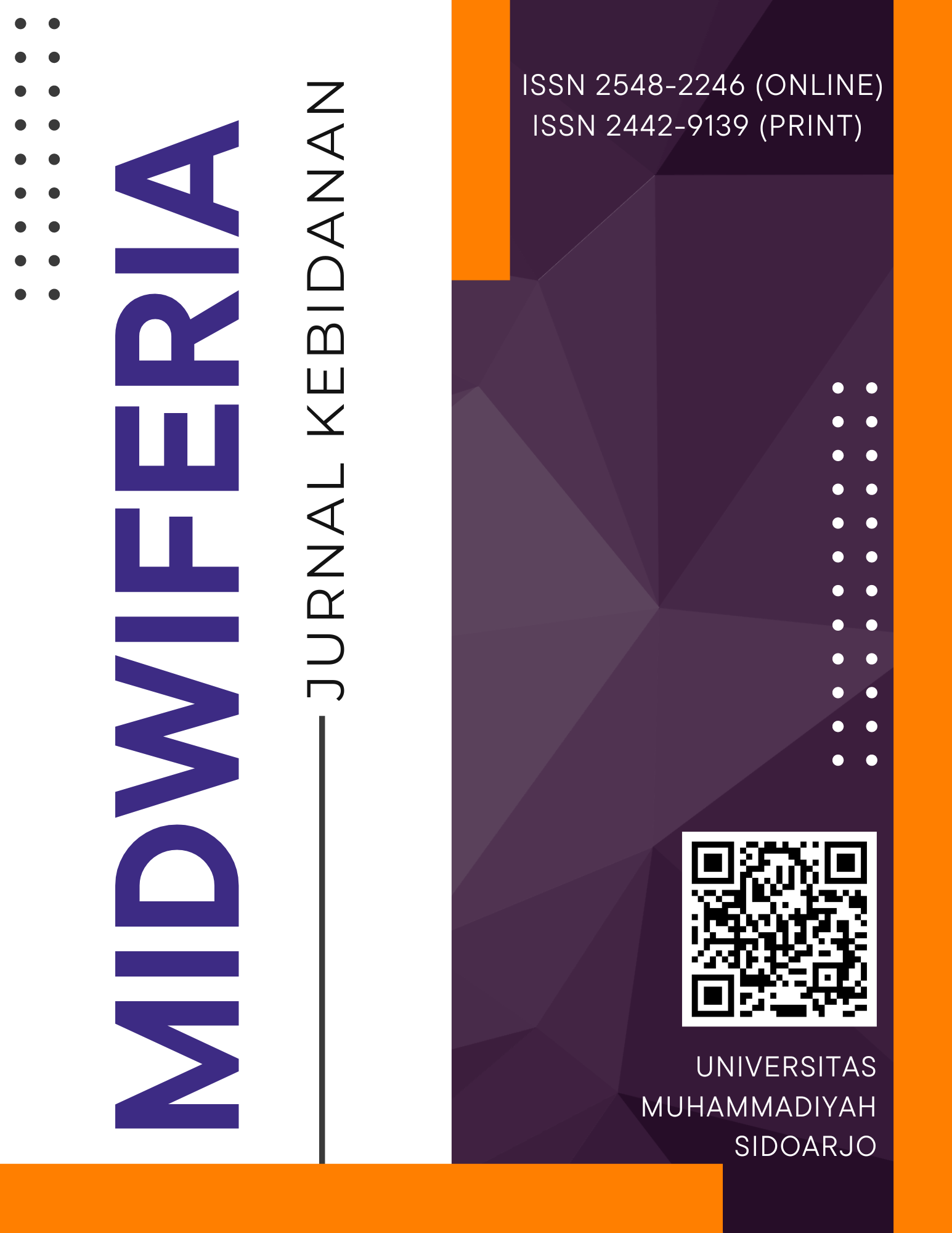Effectiveness of Ketoprofen Suppositories in Reducing the Risk of Preterm Labor at a Teaching Hospital in Malang
DOI:
https://doi.org/10.21070/midwiferia.v11i2.1730Keywords:
uterine contractions, imminent preterm labor, ketoprofen suppository, tocolyticAbstract
Partus prematurus imminens (PPI) was a condition that threatened preterm labor, marked by labor signs before term (20 to <37 weeks) and birth weight under 2500 grams. Management included rest, hydration, and pharmacological measures. One approach used to delay labor was tocolytic therapy, such as ketoprofen suppositories, to inhibit uterine contractions. This study aimed to analyze the difference in uterine contractions before and after the administration of ketoprofen suppositories in women at risk of preterm labor. This study used a quasi-experimental design with a pre-test and post-test without a control group. The sample included 30 pregnant women with PPI who met the inclusion criteria. Consecutive sampling was used. The intervention administered was ketoprofen suppository therapy, 200 mg (2 tablets) given rectally. Data were collected using an observation sheet and analyzed using the Wilcoxon signed-rank test. The results showed that the mean uterine contraction score before therapy was 2,17, which decreased to 1,20 after therapy. There was a statistically significant difference in uterine contractions before and after the intervention. The Wilcoxon signed-rank test resulted in a p-value of 0,001 (p ≤ 0,05). The findings indicated a significant difference in uterine contractions before and after the administration of ketoprofen suppositories in pregnant women at risk of preterm labor. Ketoprofen suppository therapy was effective in reducing uterine contractions in pregnant women at risk of preterm labor, with routine fetal monitoring ensuring the safety of the intervention.
References
Arifah, D. F., & Mudlikah, S. (2024). Paritas dan usia ibu dengan anemia kehamilan di Puskesmas Nelayan Kabupaten Gresik. Jurnal Kebidanan, XVI(01), 45–55. https://doi.org/10.35872/jurkeb.v16i01.720
Casanova, R., Chuang, A., Goepfert, A. R., Hueppchen, N. A., & Weiss, P. M. (2019). Beckmann and Ling’s Obstetrics and Gynecology Eighth Edition. In Wolters Kluwer business. https://books.google.com/books?hl=en&lr=&id=pRHAEAAAQBAJ&oi=fnd&pg=PT21&dq=reproductive+health+education&ots=0izs49IYqk&sig=I46ehJ8yqsNKJwCMVcLTmSgsv04
Dinkes Provinsi Jatim. (2021). Profil Kesehatan Provinsi Jawa Timur Tahun 2021. Profil Kesehatan 2021, 3(1), 1–152. https://doi.org/10.21831/dinamika.v3i1.19144
Dinkes Provinsi Jatim. (2022). Profil Kesehatan Provinsi Jawa Timur Tahun 2022. Profil Kesehatan Provinsi Jawa Timur 2022, 16(2), 1–215.
Dumilah, R. (2019). Umur, interval kehamilan, kehamilan yang diinginkan dan perilaku pemeriksaan kehamilan. Jurnal Penelitian Kesehatan Suara Forikes, 10(2), 73–79.
Irwan, A. A., Kabo, P., Wahyudi, E., Mappaware, N. A., & Djabir, Y. Y. (2022). Perbandingan efek antara pemberian nifedipin dan salbutamol sebagai tokolitik pada ibu hamil dengan ancaman persalinan prematur. Jurnal Kesehatan Reproduksi, 8(3), 173–179. https://doi.org/10.22146/jkr.67578
K, P. A. (2019). Konsep Dasar Persalinan. Konsep Dasar Persalinan, 1–13. https://doi.org/10.21070/2019/978-602-5914-75-1
Karmelita, D. M. (2020). Efektivitas nipedipin sebagai tokolitik dalam persalinan prematur. Jurnal Kedokteran STM (Sains Dan Teknologi Medik), 3(2), 49–58. https://doi.org/10.30743/stm.v3i2.54
Kirana, P. A. L. A., Islamy, N., & Yonata, A. (2020). G4P3A0 Hamil 30 minggu belum inpartu dengan partus prematurus imminens dan ketuban pecah dini. Medula, 10, 456–460. http://journalofmedula.com/index.php/medula/article/view/94
Kuczynska, J., & Nieradko-Iwanicka, B. (2022). New uses of ketoprofen - a review of studies from 2015 to 2021. Current Issues in Pharmacy and Medical Sciences, 35(1), 16–20. https://doi.org/10.2478/cipms-2022-0004
Kuczyńska, J., & Nieradko-Iwanicka, B. (2021). Future prospects of ketoprofen in improving the safety of the gastric mucosa. Biomedicine and Pharmacotherapy, 139. https://doi.org/10.1016/j.biopha.2021.111608
Lontaan, G. I. A., Wagey, F. W., & Tendean, H. M. M. (2025). Hubungan faktor-faktor risiko dengan persalinan prematur di RSUP Prof. Dr. R. D. Kandou Manado Periode 2021–2022. E-CliniC, 13(1), 78–84. https://doi.org/10.35790/ecl.v13i1.60616
Maddeppungeng, N. M., & Rahman, L. (2021). Peningkatan laju disolusi ketoprofen yang diformulasikan dengan metode self emulsifying drug delivery system (SEDDS). Jurnal Sains & Kesehatan, 3(1), 24–34.
Raihana, D., Nursucahyo, E., Dwi, N., & Muhammad, A. (2023). Hubungan anemia dalam kehamilan dengan kejadian persalinan prematur di RSUD Haji Provinsi Jawa Timur. Fakultas Kedokteran Universitas Muhammadiyah Surabaya.
WHO., 2018. 'Kelahiran prematur', retrieved: September 22, 2024, from https://yankes.kemkes.go.id/view_artikel/603/perawatan-bayi-prematur
WHO., 2021. 'Kelahiran prematur', retrieved: September 20, 2024, from https://www.who.int/news-room/fact-sheets/detail/preterm-birth
Wurnayingsih, S. (2019). Profil peresepan tokolitik pada pasien abortus imminens dan persalinan prematur di Klinik Obsgyn RS Muhammadiyah Lamongan. Jurnal Keseahatan Politeknik Kesehatan Tanjung Karang, 53(9), 1689–1699.
Yulianto Sarim, B., & Suryono, B. (2020). Manajemen nyeri kronis pada kehamilan. Jurnal Anestesi Obstetri Indonesia, 2(1), 48–62. https://doi.org/10.47507/obstetri.v2i1.34
Yuriati, P., & Khoiriyah, E. (2021). Persalinan nyaman dengan teknik rebozo. Jurnal Ilmu Keperawatan Dan Kebidanan, 12(2), 287. https://doi.org/10.26751/jikk.v12i2.1052
Yurmansyah, A. (2018). Perbedaan pemberian analgetik ketoprofen suppositoria dan ketoprofen injeksi intravena terhadap rasa nyeri pada pasien pasca hemoroidektomi whitehead. 4(1), 18–50. https://digilib.uns.ac.id/dokumen/detail/72149/
Downloads
Published
Issue
Section
License
Copyright (c) 2025 Tri Isworowati, Budi Utomo, Ratna Dwi Jayanti

This work is licensed under a Creative Commons Attribution 4.0 International License.






